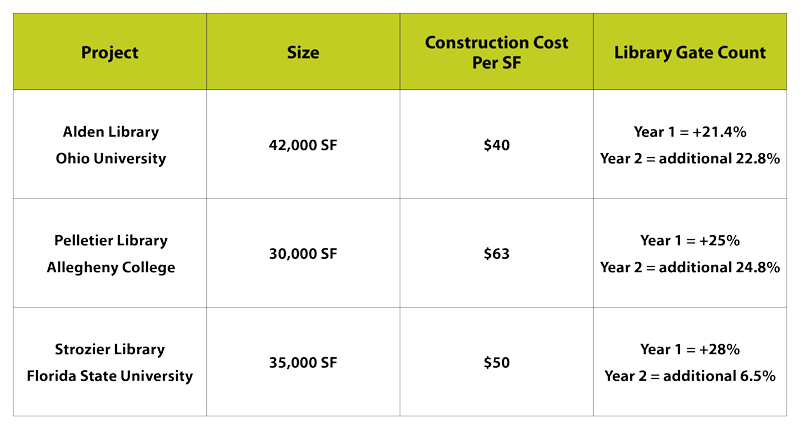The growing trend of renovating libraries has reshaped the way libraries are being viewed and used on campuses throughout the country. The creation of a learning commons takes outdated libraries and transforms them into the heart of learning for the academic community.
Why learning commons?
Learning commons incorporate two key components that are necessary for the immediate and future needs of libraries: flexible spaces and technology.
- Flexible Spaces. Research conducted by the National Training Laboratories in Bethel, Maine, shows that learning retention greatly increases when students participate in group discussion, practice by doing, and teach others. The spaces in the learning commons provide a variety of options to accommodate both individual and group work including: quiet study areas, conference rooms, and computer stations. Providing students with a variety of spaces and making them flexible allows students to engage. “When we surveyed students after the renovation, they told us that the library became the place to be on campus,” said Julia Zimmerman, former dean of libraries at Ohio University. The flexible spaces in the commons are complemented with flexible furniture making it practical and functional. Large, heavy sofas have been replaced with lighter, modular pieces that can be easily moved to create different seating arrangements depending on the size and needs of various groups. Flexible spaces and furniture have the additional benefit of accommodating future growth and changes.
- Technology. Many academic libraries were built in the 60's, 70's and 80's, before computers. The main purpose of the library was to house books, which were the format for knowledge at the time, and to provide quiet study with carrels and study tables in reading areas. Today’s students live in a digital world with rapidly developing technology. They expect to be connected wherever they are and technology is the learning tool they use. Because the area of libraries is mostly occupied with books, few computers, and uncomfortable but durable furniture, most students use the library sparingly. Most faculty members, with the exception of those in the humanities department, seldom occupy the library because most of the information in their field is ever changing and the most current information is found through digital formats. Case in point, technology is recognized as an essential tool for learning that needs to be carefully considered in the design of the learning commons. Computers are no longer placed in a dedicated room; they are located everywhere in the commons, in open stations for individual or group use. Work surfaces have the ability to accommodate personal, portable device usage, which has become the norm. As well, large display screens are necessary in group study areas for collaborative viewing and discussion of information.
DesignGroup has collaborated with 12 colleges and universities to create academic learning commons, where students collaborate to turn information into knowledge. The following chart shows the results of three of our largest renovation projects that have been in use for over two years:
What are the benefits of learning commons?
- Modest investment for dramatic improvements. The cost of library renovations is economical because by nature, they simplify and open up the space. Dramatic improvements occur with investments in flexible furniture and the reconfiguration of group spaces. As noted in the chart above, the average cost per square foot is $50, which delivers an average increase of 25% in student usage in the first year alone.
- Increased Library Usage. Not only do students visit the library more frequently, but they stay for longer periods of time. For many students, the library has once again become a destination on campus, embracing the notion of “see and be seen.” Phyllis O’Connor, acting Dean of Libraries at The University of Akron, stated, “Since the renovation to create the learning commons, the library is full all the time. The library was nearly empty on Fridays because most students don’t have class on that day. Now, it is completely full, even on Fridays.” The learning commons gives students the tools they need to build their intellectual capital, which is where their efforts should be channeled throughout the life of their college experience.
- Recruiting Tool. Libraries are an opportunity for colleges and universities to showcase their culture on campus. This is an important consideration for prospective students and their parents in their decision making process. Linda Bills, Library Director at Allegheny College, notes that due to the renovation, the library is now the first stop on their campus tour for new students.
Key questions to ask during planning:
- Is the library open and transparent giving students the ability to “see and be seen”?
- Does it provide visible closed group study spaces that vary in size?
- Is the atmosphere inviting, comfortable, and reflect the culture of the college/university?
- Are there open seating areas that encourage collaboration?
- Are there student help areas available, such as academic advancement center, writing center, subject tutoring?
- How will the service model evolve to support greater collaboration among students, faculty and staff?
There is no one-size-fits-all when it comes to learning commons. There are key components that need to be incorporated in order for it to be relevant to the needs of today’s users, but its success relies on the ability of the academic institution to address their areas of opportunity and involve their users in the process, as their voices are invaluable. Together, an open, inviting space can be created that gives students the opportunity to study, collaborate, learn, and research in a social atmosphere. Students will discover the library to be a place where they can meet and engage in collaborative learning to enhance their education, and become better prepared for the real world.
